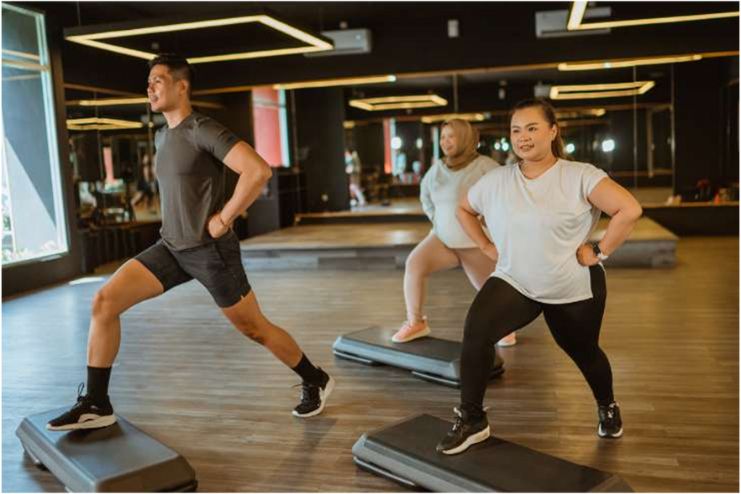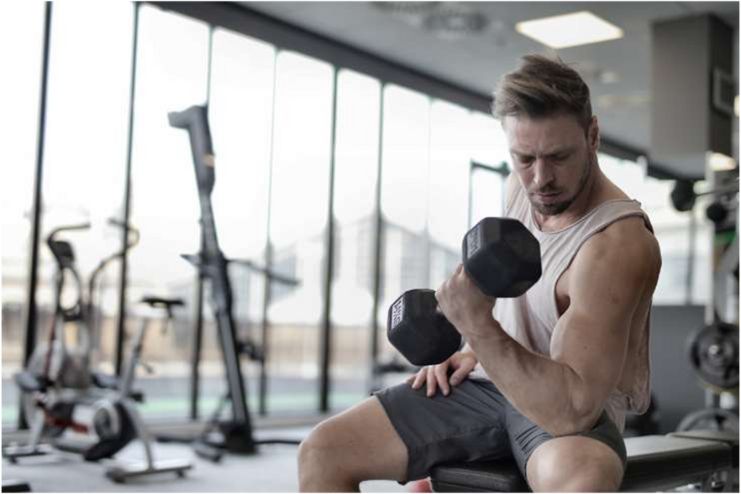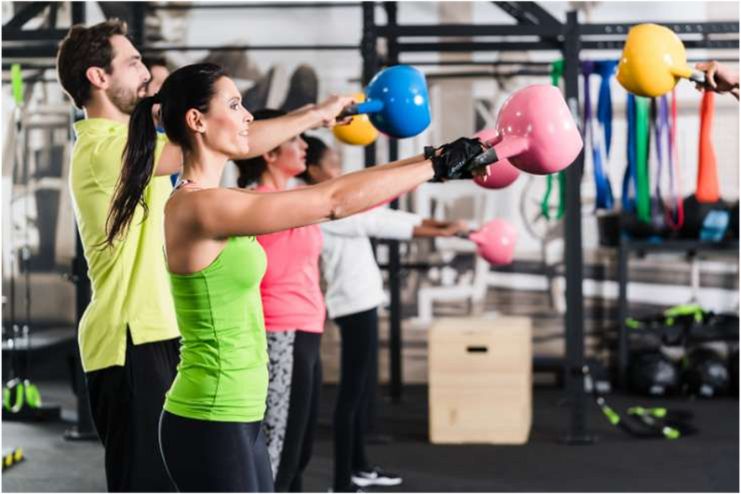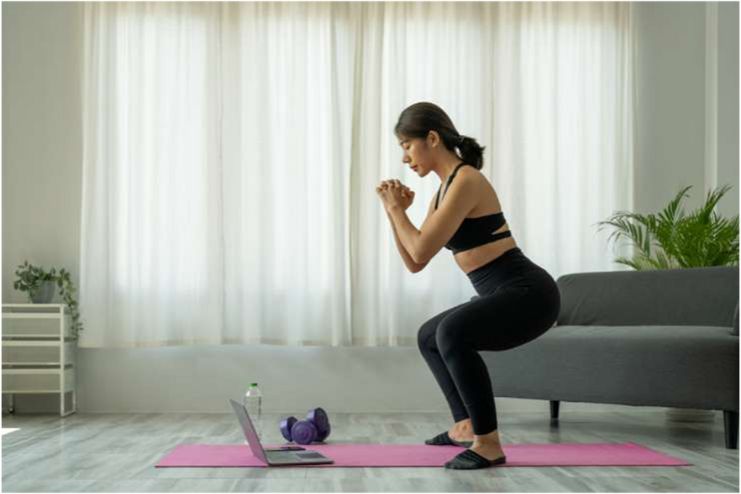AI Contribution
At HealthSpectra, we may use AI to refine grammar and structure, but every piece is shaped, checked, and approved by real people, our expert writers and editors, to ensure clarity, credibility, and care. Learn more..Affiliate Disclaimer
Some links in this article are affiliate links. We may earn a small commission if you make a purchase through these links, at no extra cost to you. We only recommend products we find useful to our readersLike the shifting sands of time, the fitness industry is constantly changing. Fitness trends change over time, combining physical well-being, mental health, and technology. The industry promises to offer a blend of tried-and-true techniques and innovative fitness trends while raising awareness of health and well-being.
Fitness nowadays is a blend of innovation and tradition, from the peaceful embrace of yoga hybrids to high-intensity interval training (HIIT). These trends make fitness a more fun and inclusive experience by redefining how we approach our health, not just how we work out.
Staying up to date on the latest fitness trends is now essential for everyone looking for variety and long-term results.
This article will examine eight modern fitness trends that are revolutionizing the way we think about exercise and will help you find new ways to stay active, have fun, and successfully reach your fitness objectives.
Unveiling the Game-Changing Fitness Trends
1. High-Intensity Interval Training (HIIT)

High-Intensity Interval Training (HIIT) is at the forefront of revolutionary workout efficiency. Due to its potential to produce the most significant effects in the shortest amount of time, this powerful fitness trend has become increasingly popular.
It consists of multiple rounds alternating between brief intervals of lower-intensity movements and several high-intensity motions to raise the heart rate to at least 80% of one’s maximal heart rate.
Any cardiovascular activity, such as jogging, stair climbing, rowing, or jumping rope, can be combined with HIIT. You’ll increase your metabolism, gain muscle, and also lose weight. Additionally, your body will continue to burn calories for approximately two hours following your workout.
The 1950s saw the introduction of interval training as a more intense variation known as sprint interval training. This training was designed to boost the performance of top Olympic athletes and achieve a maximum heart rate of 100%.
2. Wearable Technology and Fitness Trackers

Wearable technology is leading the digital transformation of the fitness industry. Until now, we’ve only had a few tools to track our every step, inside and outside the gym, from simple fitness trackers and GPS running watches to arm straps with biometric sensors and bright rings for recovery tracking.
Fitness trackers and smartwatches allow users to check their progress in real time, which can help them stay motivated and improve their workout regimens. Biometric sensors, a recent development in wearable technology, can identify early indicators of stress, weariness, and possible injury hazards. These advanced gadgets now have AI-powered coaching capabilities that give users immediate feedback while they work out, guaranteeing correct form and intensity levels.
The Manpo-kei, or “10,000 steps meter,” created by Dr. Yoshiro Hatano in 1965, introduced fitness trackers as we know them today. At the time, Dr. Hatano, a professor from Kyushu University of Health and Welfare in Japan, was investigating ways to fight obesity.
According to his theory, 10,000 steps offered the ideal ratio of activity-based calorie expenditure to caloric intake for a healthy body. While 10,000 steps are still the standard objective on modern fitness monitors, a new study in the International Journal of Obesity indicates that 15,000 steps would be a better goal.
3. Group Training and Community Workouts

The days of working out alone are over; with the popularity of group training and community workouts, fitness has become a shared activity. Whether it’s yoga, spin classes, or boot camps, working out with others adds an unmatched drive and enthusiasm.
Group training provides various fitness options, from yoga to high-intensity interval training. In addition to allowing people to try different workouts, group fitness courses foster a sense of accountability and community that can support participants in maintaining their fitness objectives.
Exercises in the community also offer a strong network of support. They hold you responsible on bad days and acknowledge and appreciate your minor achievements. One of the key advantages of group exercise courses is the social component. Exercise in a group environment fosters a sense of camaraderie that helps keep people accountable and motivated.
Participants in group fitness programs frequently have similar fitness objectives, such as remaining active, increasing strength, improving cardiovascular health, or decreasing weight. This common goal creates a positive atmosphere where everyone supports one another’s success.
4. Bodyweight Training

Bodyweight training has returned with a bang, revolutionizing fitness with its ease of use, adaptability, and efficiency. This movement highlights the raw power of the human body, showing that you can build strength, flexibility, and endurance without expensive equipment.
Exercises involving bodyweight training employ the weight of your body as resistance. They often work a variety of muscles and promote your strength and stability. You can perform them almost any place because you don’t need any equipment or weights. Additionally, you can modify these forms of exercise to suit your needs. Therefore, there are significant advantages for beginners as well as professionals.
Physiology and Behavior revealed that bodyweight bodyweight exercises, a type of resistance training, aid in muscle growth “independent of an external load.” However, they do more than that. Researchers reported gains in seven of nine physical fitness markers after examining the effects of ten weeks of bodyweight workouts on a small group of young women.
Bodyweight training requires little room and dedication; you don’t need gym memberships or equipment. It’s fitness on your terms. To alter some movements, you may need a few props, like a chair, bench, or counter, but you already have all of these things.
5. Functional Fitness Workouts

You’ve probably seen the term “functional training” used recently in gym ads, fitness magazines, and social media videos. It’s been a popular training term for decades. Regretfully, a term used to describe a particular training style can occasionally become trendy and utilized too broadly in the fitness industry.
What it means to be truly fit is being redefined by functional fitness exercises. This trend stresses motions that mimic everyday tasks, including bending, lifting, pushing, pulling, and twisting, rather than just aesthetics or isolated muscle training. It all comes down to developing strength in your daily activities.
Although this is just one example, our bodies naturally move in various ways that align with human movement patterns. We rotate, squat, lunge, step up, hinge at the hips, and push and pull with our upper body.
Training in each of these motions aims to maintain muscle function as intended. Compound motions, which include bending at many joints and using numerous muscle groups to accomplish the movement, are commonly used in functional training.
Functional fitness improves resilience and longevity in addition to physical benefits. Lifetime training will enable you to move more effectively, stay injury-free, and remain active well into old age. It is a lifelong change for a stronger, more capable person, not merely a fitness fad.
6. Virtual and On-Demand Workouts

Exercises conducted virtually are at the forefront of the fitness industry’s digital transformation. With a swipe, these platforms allow you to access a vast library of on-demand workouts, bringing the gym into your living room.
Users of virtual fitness benefit from a stress-free training environment, boosted self-esteem, and a sense of community. It may explain the 12% increase in live class participation that virtual training has been shown to produce.
Why is this trend revolutionary? It’s practical, diverse, and customizable. With the best trainers at your disposal, you have access to an endless array of frequently customized classes to meet your objectives. Additionally, many systems use live leaderboards and gamification to make fitness enjoyable and competitive.
Additionally, hurdles like time limits, travel, and even intimidation are overcome via virtual workouts. They make fitness more accessible and flexible to fit into today’s hectic lives, democratizing it. On-demand and virtual exercises have entirely changed how we stay active by bringing the fitness of the future to your screen.
7. Mind-Body Practices

In today’s fast-paced society, fitness is changing to embrace mental-physical balance and physical strength. Mind-body practices employ methods that improve the relationship between our physical, mental, and emotional selves. Breathwork, meditation, progressive muscular relaxation, yoga, tai chi, guided imagery, and general relaxation techniques are a few examples.
A medical technique that helps people relax mentally and physically by combining bodily movements, controlled breathing, and mental focus. It can improve general health and manage pain, tension, anxiety, and depression.
In response to your experiences, behaviors, ideas, emotions, illness, and damage, the brain can rearrange itself by forming new neural connections. The brain is a very dynamic organ that evolves throughout life.
Knowledge of neuroplasticity is the foundation of mind-body skills. The more you practice, the more you strengthen the connection and develop neural pathways between the mind and body. Exercise truly alters your brain’s structure and function.
The versatility of mind-body practices—their use by people of various ages and fitness levels—makes them a subtle yet profound complement to any program. These activities are now crucial for attaining balance, resilience, and a greater sense of well-being in a time when wellness is more than just working out.
8. Recovery and Regeneration Techniques

Fitness now involves more than pushing boundaries; it also involves understanding when to take a break and prioritizing recovery. Fitness regimens are changing because of the emphasis on rest and regeneration approaches, which make rest as important as exercise.
Although athletes know the need for efficient training, they usually give sports healing less thought. Nonetheless, athletes’ restoration is likely equally crucial to their performance and stamina and merits the same consideration. According to performance technologist Brian George of the Center for Sports Performance and Research, “Recovery strategies are a key part of athletic performance.”
Hydrotherapy, active recovery, stretching, compression clothing, and massage are some of the more popular recovery methods athletes use. Research on the impact of recovery on performance and possible pathways has significantly increased during the last five to ten years.
Not to be overlooked is the unsung hero of healing: getting enough sleep. The magic happens when you get enough good sleep, allowing your mind to clear and your muscles to strengthen. This pattern acknowledges that healing is a strategy rather than a sign of weakness.
Conclusion
Trends that rethink how we move, recover, and connect drive an exciting shift in the fitness industry. Thanks to advances like wearable technology, HIIT, group exercises, and mind-body techniques, fitness is now more dynamic, inclusive, and efficient. Incorporating science, creativity, and holistic well-being into our daily routines encourages us to think beyond the treadmill.
Adopting these revolutionary ideas may improve your fitness journey, maintain your motivation, and find new ways to push yourself. It’s time to sweat smarter, not harder. Investigate, try new things, and allow these breakthroughs to reshape your journey to health and vitality.
References
- https://www.fitbudd.com/post/the-future-of-fitness-trends-top-trends-to-watch-in-2025
- https://3dlook.ai/content-hub/top-fitness-industry-trends/
- https://www.webmd.com/fitness-exercise/a-z/high-intensity-interval-training-hiit
- https://nutritionsource.hsph.harvard.edu/high-intensity-interval-training/
- https://www.winterberrymedical.ca/2021/08/17/do-you-really-need-10000-steps-a-day/
- https://www.menshealth.com/uk/gym-wear/a46499341/wearable-fitness-tech-guide
- https://fitness.edu.au/the-fitness-zone/the-power-of-group-fitness-classes-finding-community-and-motivation
- https://eliteclubs.com/the-benefits-of-group-fitness-classes-finding-community-and-accountability
- https://www.webmd.com/fitness-exercise/ss/slideshow-bodyweight-exercises
- https://www.health.harvard.edu/exercise-and-fitness/the-advantages-of-body-weight-exercise
- https://www.health.harvard.edu/exercise-and-fitness/the-advantages-of-body-weight-exercise
- https://www.muscleandfitness.com/routine/workouts/workout-routines/the-functional-workout-routine
- https://www.webmd.com/fitness-exercise/how-to-exercise-with-functional-training
- https://www.studiosweatondemand.com/sweatpro
- https://www.harborathletic.com/programs/virtual-options
- https://www.cancer.gov/publications/dictionaries/cancer-terms/def/mind-body-practice
- https://www.takingcharge.csh.umn.edu/survivorship/what-are-mind-body-practices
- https://www.iasp-pain.org/resources/fact-sheets/mind-body-practices
- https://www.massgeneralbrigham.org/en/about/newsroom/articles/recovery-for-athletes
- https://www.gssiweb.org/sports-science-exchange/article/sse-120-recovery-techniques-for-athletes






















